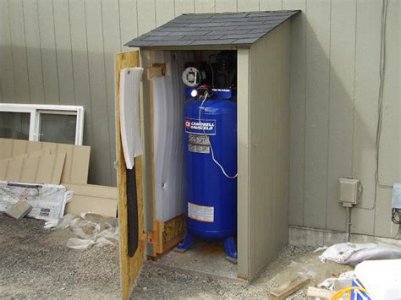- Joined
- Jan 2, 2019
- Messages
- 7,163
Okay, I'm not going to get into any of the engineering aspects of this and go straight for the practical side of things.
Why not just do what professional shops do and build a shed on the outside of your shop? Increase the holding tank capacity if you need more volume and call it a day.

Harbor Freight makes some good equipment but I doubt their compressor pumps are that great. If they will give you an extended warranty that would be a good purchase regardless of how fast you want to run it.
I guess for me an air compressor is a single purpose tool that just has to do what I need day in and day out. The companies that build them have engineering staff that have probably tried doing what you propose and either found out it didn't make a big difference or it increased the price above what their customers would pay.
Another advantage of moving the compressor out of the shop besides keeping coffee off your pants is a tank failure is much less likely to kill you or bust up the shop.
Just some thoughts from a practical guy who would like to move his compressor outside and use the floor space for more machine tools
John
Why not just do what professional shops do and build a shed on the outside of your shop? Increase the holding tank capacity if you need more volume and call it a day.

Harbor Freight makes some good equipment but I doubt their compressor pumps are that great. If they will give you an extended warranty that would be a good purchase regardless of how fast you want to run it.
I guess for me an air compressor is a single purpose tool that just has to do what I need day in and day out. The companies that build them have engineering staff that have probably tried doing what you propose and either found out it didn't make a big difference or it increased the price above what their customers would pay.
Another advantage of moving the compressor out of the shop besides keeping coffee off your pants is a tank failure is much less likely to kill you or bust up the shop.
Just some thoughts from a practical guy who would like to move his compressor outside and use the floor space for more machine tools

John

